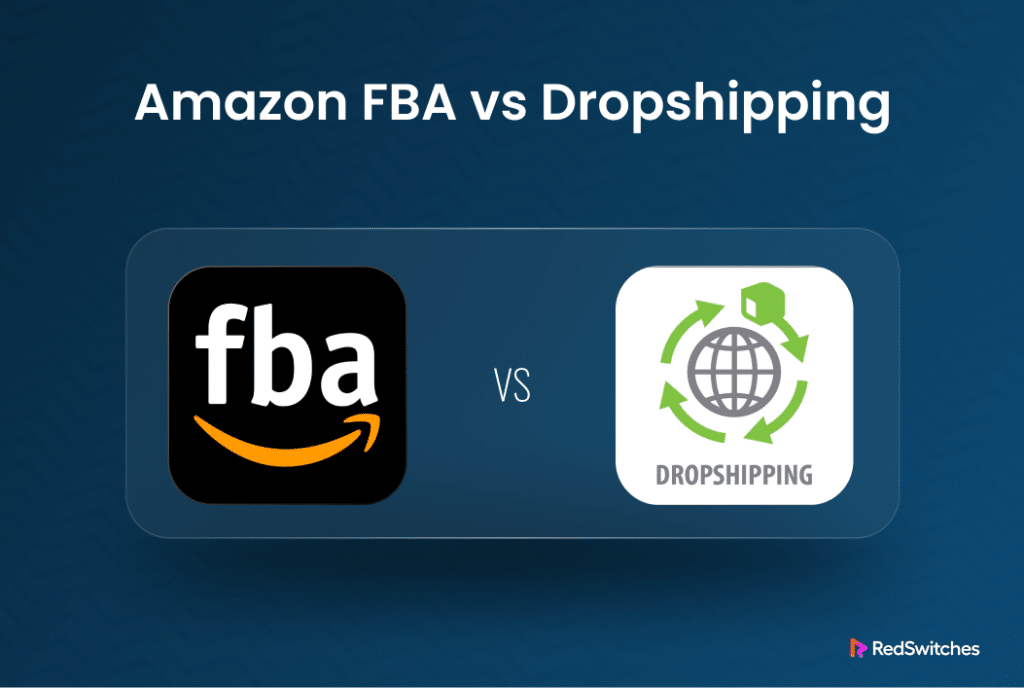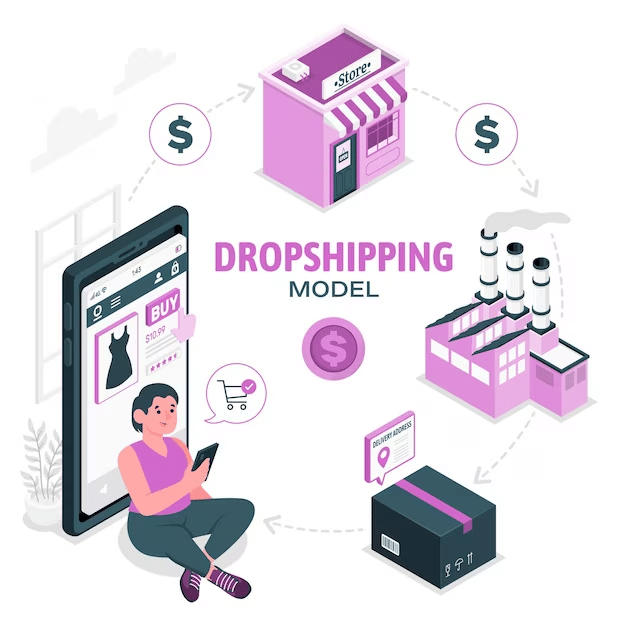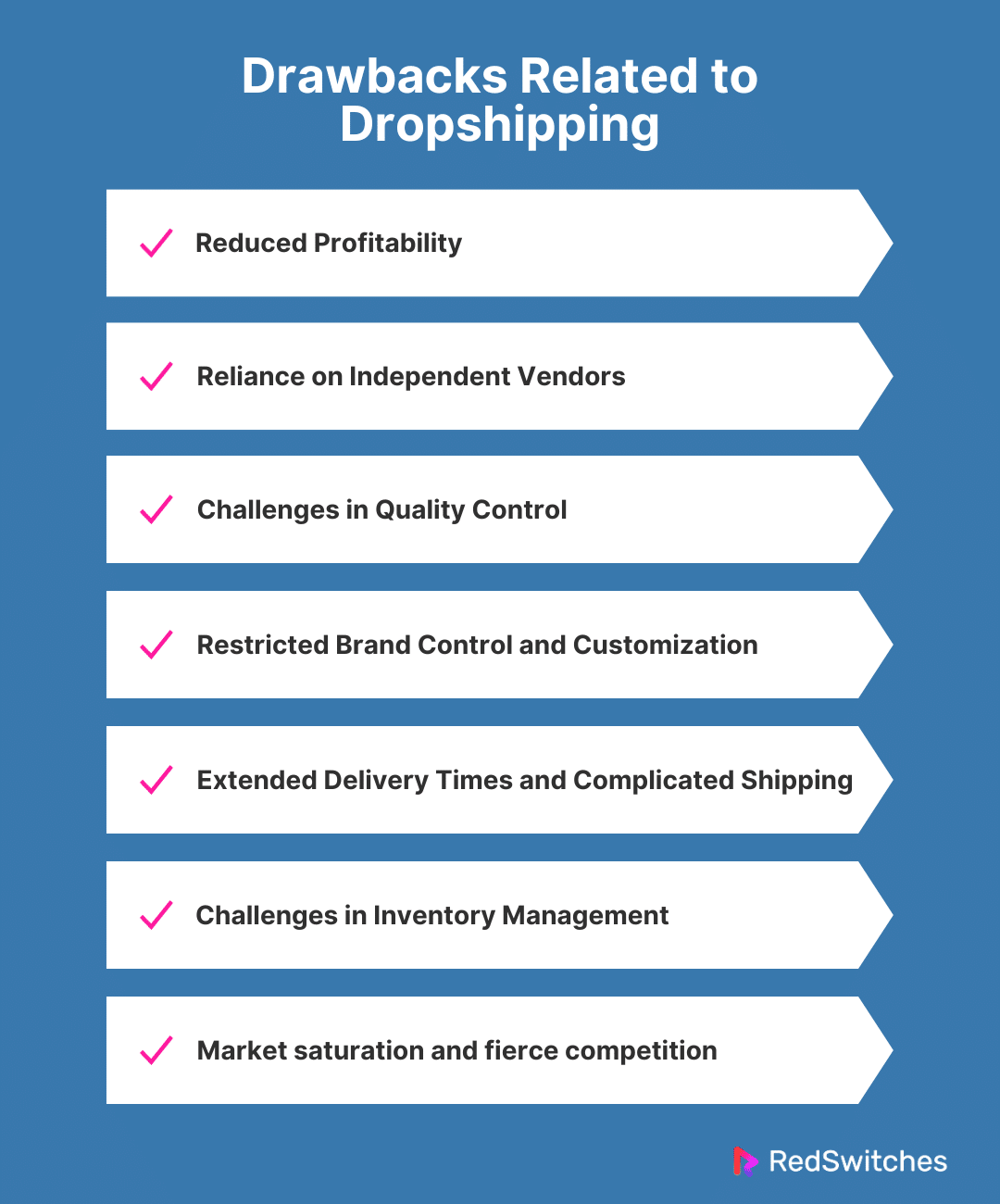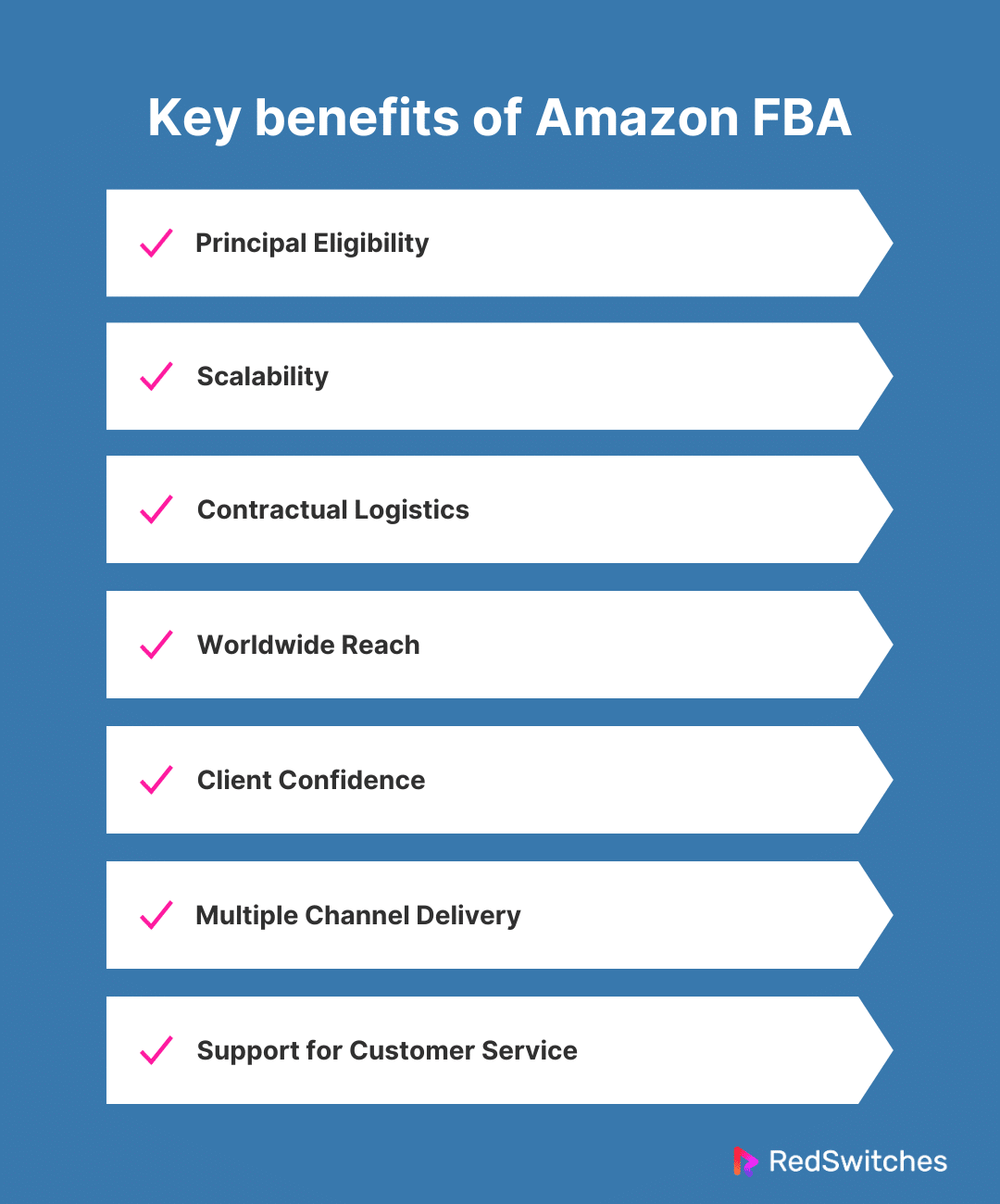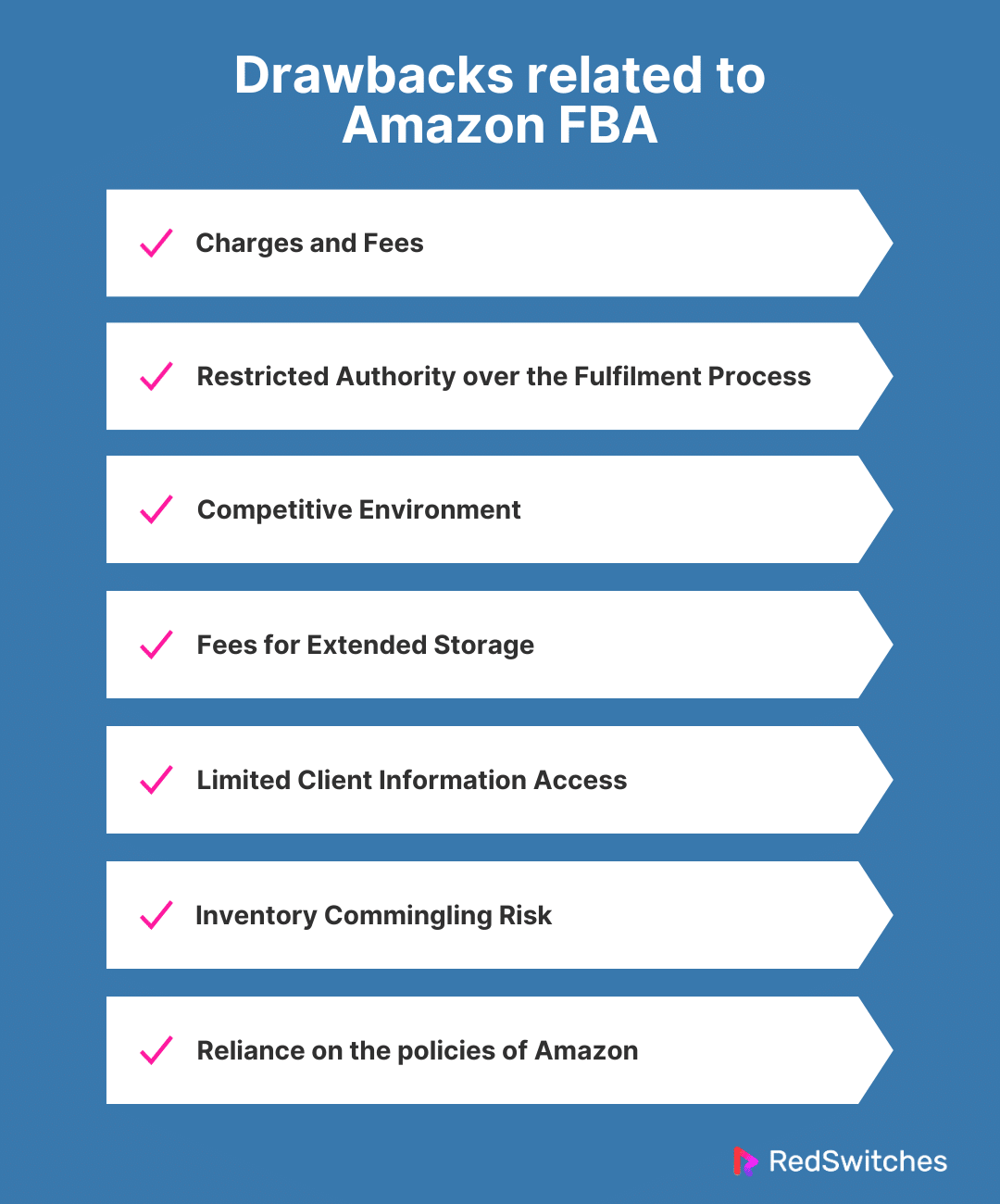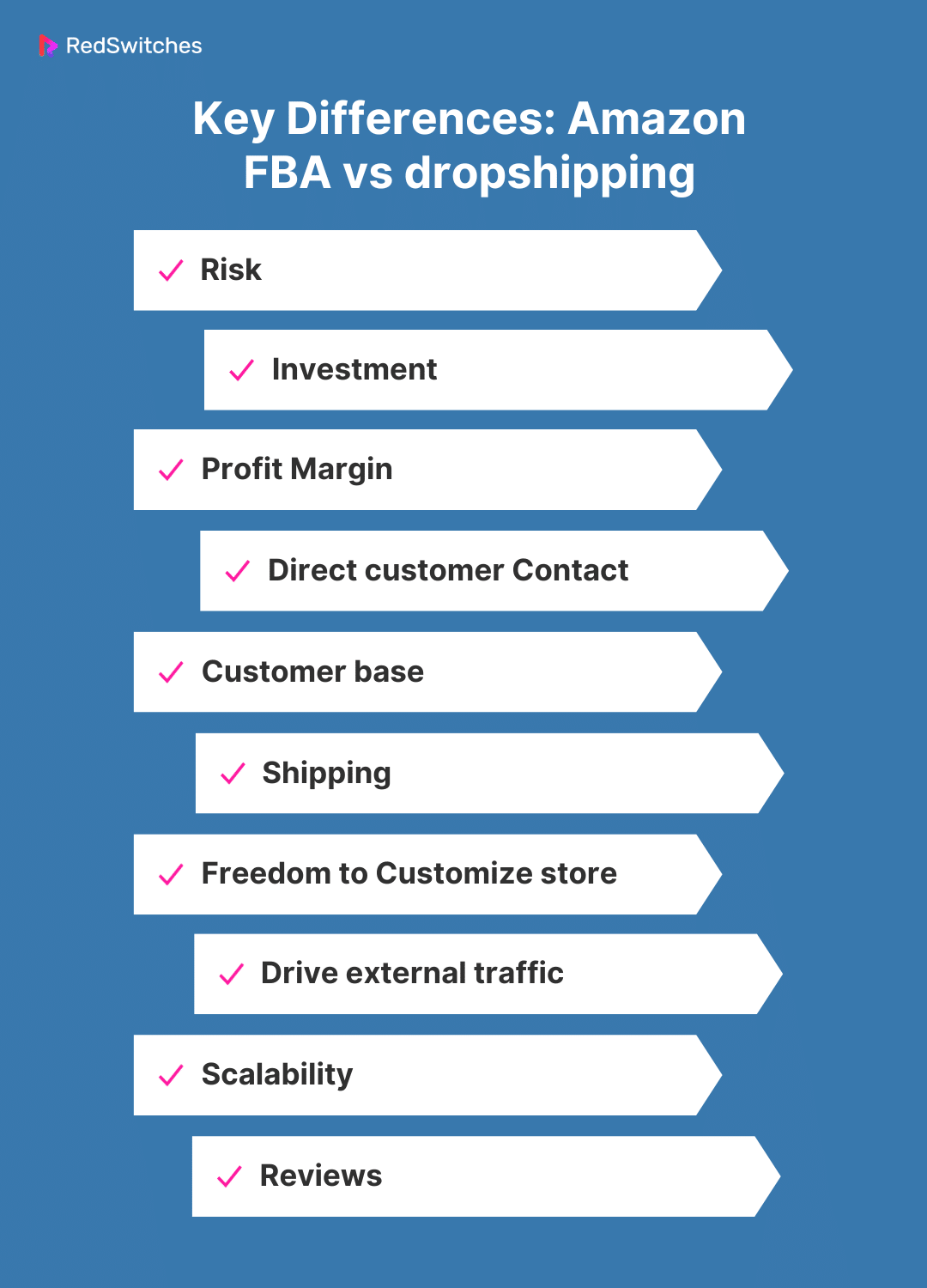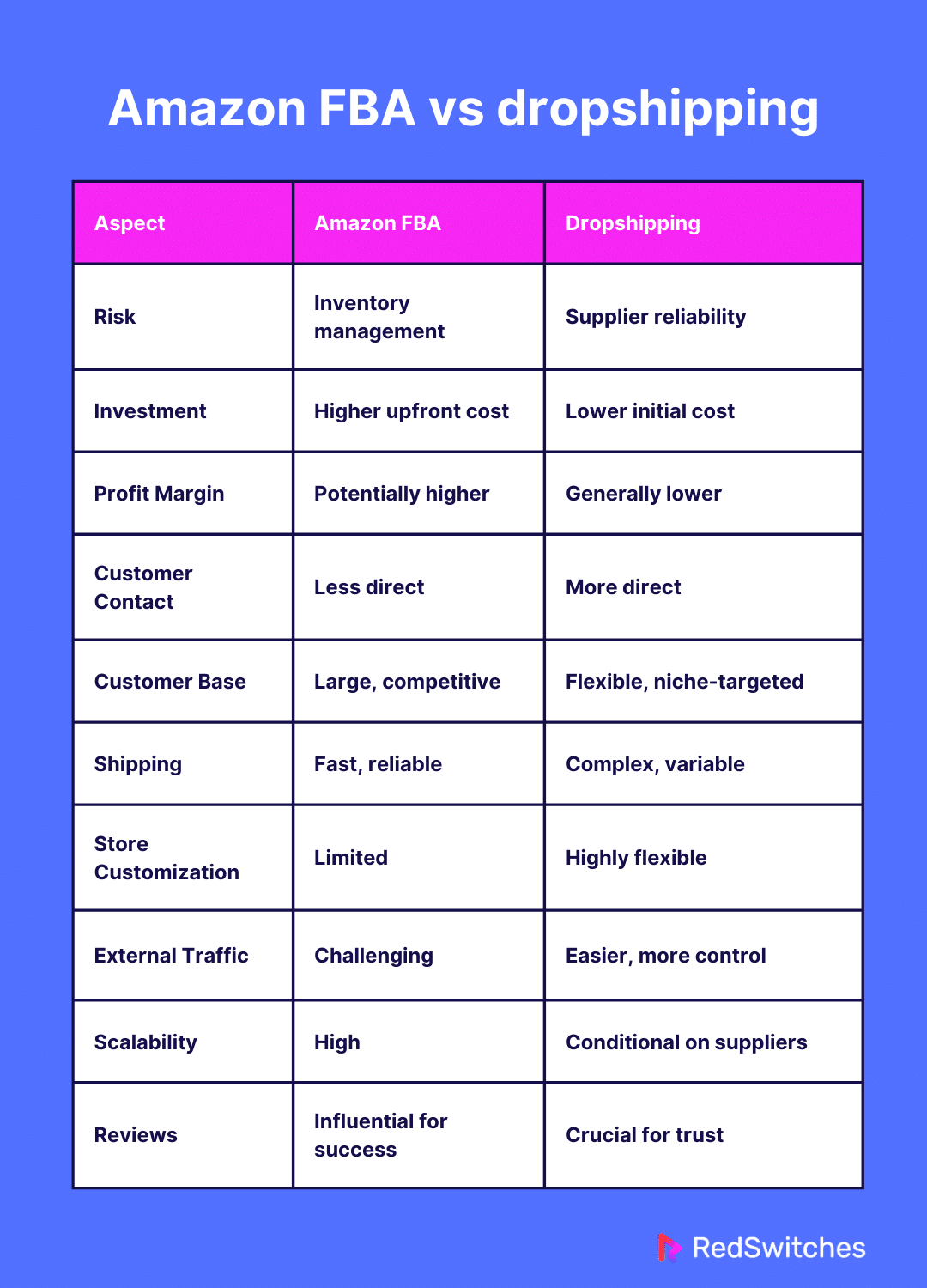Key Takeaways
- Amazon FBA offers scalability and ease of operation, handling logistics, fulfillment, and customer service.
- Dropshipping emphasizes minimal upfront investment and flexibility, allowing entrepreneurs to start an e-commerce business with low risk.
- Amazon FBA requires a higher initial investment and involves risks related to inventory management.
- Dropshipping offers a lower financial barrier to entry and minimizes stock-related risks.
- Amazon FBA can potentially offer higher profit margins per sale due to Prime eligibility and faster shipping, but it involves higher operating costs.
- Dropshipping usually has lower margins due to intense competition and reliance on supplier pricing.
- Dropshipping provides direct customer contact, offering greater control over the shopping experience and branding.
- Amazon FBA limits direct communication and branding opportunities but provides a trusted transaction platform.
- Both models offer scalability, with Amazon FBA providing infrastructure to handle increased order volumes without logistical headaches.
Amazon FBA and dropshipping are two titans. They are set to dominate in the vast and ever-changing world of e-commerce. Here, innovation and consumer demand go hand in hand.
Imagine this: an online marketplace that entrepreneurs are determined to dominate. They have put on their armor of ambition. This is a digital battleground. Our goal as we enter this virtual environment is to piece together the complex story of the dropshipping vs Amazon FBA controversy. We will understand the dropshipping vs amazon fba Debate in detail.
Today, we set out to explore. We will remove the layers to uncover the ten crucial distinctions that will shape the futures of these two titans. So buckle up and come along as we explore a corporate battlefield where tactics collide and millions are at stake.
Welcome to the Amazon FBA vs Dropshipping showdown!
Table Of Contents
- Key Takeaways
- What is Dropshipping?
- What is Amazon FBA?
- Key Differences: Amazon FBA vs dropshipping
- Amazon FBA vs Dropshipping: Risk
- Amazon FBA vs Dropshipping: Investment
- Amazon FBA vs Dropshipping: Profit Margin
- Amazon FBA vs Dropshipping: Direct customer Contact
- Amazon FBA vs Dropshipping: Customer base
- Amazon FBA vs Dropshipping: Shipping
- Amazon FBA vs Dropshipping: Freedom to Customize store
- Amazon FBA vs Dropshipping: Drive external traffic
- Amazon FBA vs Dropshipping: Scalability
- Amazon FBA vs Dropshipping: Reviews
- Which One to Choose?
- Conclusion
- FAQs
What is Dropshipping?
Credits: Freepik
One method of selling goods online without having to maintain inventory is dropshipping. Upon receipt of an order, the vendor forwards it to a different business that ships it directly to the buyer. The seller acts as a go-between for the client and the business selling the item.
A retailer that uses dropshipping does not hold inventory for the products it sells. Rather, when a store sells anything, it buys it directly from a third party and ships it straight to the buyer. The merchant never sees or handles the product as a result.
Dropshipping’s accessibility and minimal entry barriers have led to its growing popularity in the e-commerce industry. This business strategy appeals to entrepreneurs because it enables them to launch an Internet store without requiring a substantial investment in goods.
Rather, the emphasis moves to developing a user-friendly website, implementing marketing plans, and providing a flawless client experience.
Profit margins are usually smaller than those of traditional retail methods. Dropshippers lose out on the benefits of scale that come with larger orders because they don’t purchase goods in quantity. Furthermore, heightened competition within the dropshipping industry may result in pricing pressure, further compressing profit margins.
Also read A Comprehensive Guide on How to Start an eCommerce Business
Key Benefits of Dropshipping
After discussing the definition, we will now learn the key benefits of Dropshipping.
Minimal Upfront Investment
The biggest benefit of dropshipping is that little money is needed upfront. It costs little, so entrepreneurs can launch an online store and focus on other business activities like marketing and customer acquisition. They do not need to buy or keep inventory.
Decreased Risk
Dropshipping eliminates the possibility of keeping unsold inventory or overstocking. Businesses lower their risk by buying goods only when a sale is made, minimizing the difficulty of managing excess inventory.
Flexibility and Independence from Location
Entrepreneurs can operate dropshipping businesses from any location with an internet connection. This flexibility is very tempting for those who want to run their business remotely or be location-independent.
Greater Product Variety
Dropshippers can provide a more varied selection of products because they are not limited by physical storage. This flexibility lets owners test items. They can then change their offers in response to shifting consumer needs.
Scalability
Dropshipping facilitates the rapid expansion of a business. Entrepreneurs can grow fast. They can enter new markets or add new items. They avoid the logistics of traditional inventory management.
Time Efficiency
Dropshipping relieves business owners of responsibilities like order fulfillment and inventory management. They can manage time well. This lets them focus on key parts of the company. These parts include customer support, marketing, and business growth.
Testing and Validation
Dropshipping offers a low-risk setting for product testing and validation. Entrepreneurs can test different items and market niches. They evaluate sales data and consumer feedback to find profitable endeavors and hone their business plans.
Also read 11 Best Dropshipping Web in 2024
Drawbacks Related to Dropshipping
Let us now understand the drawbacks related to Dropshipping in detail.
Reduced Profitability
The dropshipping industry can be quite competitive because of its low entry barriers and inexpensive startup costs. This rivalry frequently impacts individual businesses’ profit margins since they may have to reduce their pricing to remain competitive.
Reliance on Independent Vendors
Order fulfillment is handled by third-party providers for dropshippers. Problems with suppliers can directly affect the dropshipper’s business and reputation, such as stockouts, shipment delays, or quality issues.
Challenges in Quality Control
Quality control might be difficult to maintain because the dropshipper does not handle the actual products. Long-term success depends on delivering high-quality items as promised to clients, which can be challenging depending on outside suppliers.
Restricted Brand Control and Customization
Dropshippers frequently have little control over branding and product customization. They might be unable to regulate the packaging or add unique touches because they don’t manage the inventory, which could affect the brand’s identity.
Extended Delivery Times and Complicated Shipping
Dropshipping can involve longer shipping times, particularly when working with foreign suppliers. Increased support requests and customer dissatisfaction may result from longer delivery periods.
Challenges in Inventory Management
While dropshipping spares the dropshipper from maintaining inventory, controlling stock levels and coordinating with several suppliers can still be challenging. Orders that are not filled may be the consequence of stockouts or disparities in inventory.
Market Saturation and Fierce Competition
Because dropshipping is so simple to get into, some niches have saturated the market, making it difficult for new players to differentiate themselves. Fierce competition might make drawing in and keeping clients more difficult.
Also read Everything About eCommerce Dropshipping
What is Amazon FBA?
Credits: Amazon
You can contract with Amazon to handle order fulfillment through the Fulfilment by Amazon (FBA) program. It is a component of the completely automated suite of services known as Amazon Supply Chain. Enroll in Fulfilment by Amazon (FBA) to ship goods to its extensive worldwide fulfillment network and provide free two-day shipping for consumers using Prime.
Amazon fulfillment specialists can pick, pack, and ship orders following a customer’s purchase. They can also handle refunds and offer customer support for specific orders.
Fees related to Amazon FBA include fulfillment fees, storage fees, and extra costs for specific services. Sellers should consider these expenses when assessing the total financial benefits of using FBA for their goods.
In addition, sellers are still in charge of marketing, product sourcing, and other facets of their organization that do not involve the fulfillment process.
Sellers can store their products at Amazon Fulfilment Centres, and Amazon will handle product selection, packing, shipping, and customer support.
Key Benefits of Amazon FBA
After discussing the definition, let’s understand the key benefits of Amazon FBA in detail.
Principal Eligibility
Amazon Prime is frequently applicable to products that Amazon FBA fulfills. This is a huge benefit, given that Prime members receive quick and free shipping on qualified items. Prime eligibility can enhance a product’s visibility and appeal to consumers, which may result in higher sales.
Scalability
Sellers may effectively scale their operations with the help of FBA. Sellers don’t have to worry about handling extra shipping, finding more warehouse space, or recruiting more employees when sales rise. Because Amazon’s fulfillment centers can handle larger order volumes, retailers can concentrate on developing their product lines and clientele.
Contractual Logistics
Thanks to Amazon fulfillment, sellers may outsource the intricate and time-consuming order fulfillment processes. Amazon handles picking, packaging, shipping, and customer support, giving sellers more time to focus on other important facets of their company, such as customer acquisition, marketing, and product development.
Worldwide Reach
Amazon FBA gives vendors access to a global customer base. Without dealing with the difficulties of establishing their global logistics network, retailers can increase their market presence by leveraging Amazon’s foreign fulfillment centers and shipping infrastructure. This can be especially helpful for companies trying to enter foreign markets.
Client Confidence
Amazon is a brand that is often associated with dependability and consumer happiness. Customers frequently feel more confident about the dependability of the return policies, customer support, and delivery processes when they notice that Amazon fulfills a product. Their confidence in the Amazon brand may impact a customer’s decision to purchase.
Multiple Channel Delivery
With FBA’s Multi-Channel Fulfilment (MCF) feature, sellers can utilize Amazon’s fulfillment services to process orders from sources other than Amazon. Businesses that sell on several platforms would benefit from this since FBA allows them to centralize their fulfillment operations.
Support for Customer Service
Amazon handles customer assistance for products fulfilled by FBA. This covers responding to customer questions, handling returns, and overseeing refunds. Amazon providing customer care support to sellers can alleviate certain administrative duties and guarantee a uniform degree of assistance.
Also read Best Magento Themes and Templates for eCommerce in 2024
Drawbacks related to Amazon FBA
Before moving to the core section of our blog, i.e. Amazon FBA vs dropshipping debate, we will now understand some limitations related to Amazon FBA.
Charges and Fees
Some fees are associated with using Amazon FBA, such as fulfillment and storage fees, as well as additional costs for services like labeling and removal. These expenses may impact profit margins, particularly for low-selling products.
Restricted Authority over the Fulfilment Process
Sellers give Amazon complete control over the fulfillment process. This results in less control over shipping, packing, and selection, even when logistics are made simpler. Selling might not be able to add unique branding or alter the package.
Competitive Environment
Seller competitiveness has increased due to FBA’s popularity. In a competitive marketplace, it might be difficult for individual sellers to stand out when so many products qualify for Prime shipping.
Fees for Extended Storage
Amazon charges long-term storage costs for products kept in its fulfillment centers for an extended period. Sellers must control their inventory levels to prevent these extra costs.
Limited Client Information Access
For FBA orders, Amazon limits access to customer information. This makes it more difficult for vendors to establish direct connections with clients or compile a client database for advertising.
Inventory Commingling Risk
There is a chance of commingling inventory in the FBA program, which occurs when identical products from various sellers are stored together. If the product from another seller is poor quality, this could cause problems and damage the reputation of all vendors with the same product.
Reliance on the policies of Amazon
Amazon’s policies, which are subject to change, apply to sellers who use FBA. Changes to the FBA program’s storage restrictions, fees, or other policies may impact a seller’s business plan.
Turning a Profit Through Amazon FBA
If your long-term goal includes selling your e-commerce company, you should immediately lay a solid foundation. Online sellers can partly thrive by selecting the order fulfillment strategy that best suits their needs. Remember that prospective buyers could think twice before offering to purchase your company when it comes time to sell.
Dropshipping has advantages, but it lacks quality control, brand building, and precise and quick shipping that generate the positive profit margin required to sell a company.
Also Read: 50 Top Trending Products to Sell Online At Your Ecommerce & Dropshipping Store in 2024
Key Differences: Amazon FBA vs dropshipping
Finally, in this section of our blog, we will discuss the core part of our blog, i.e., the Amazon FBA vs dropshipping debate, in detail. Let’s move on to it.
Amazon FBA vs Dropshipping: Risk
We will compare the associated risks in our Amazon FBA vs dropshipping debate’s first section.
Amazon FBA
Inventory management is a major area where dropshipping and Amazon FBA diverge in risk. When sellers use Amazon FBA, they bear the upfront expenses related to buying and keeping inventory. This requires a monetary investment in stock, but it also guarantees control over the quality of the goods and permits more predictable fulfillment procedures.
This strategy works best for vendors who wish to guarantee a steady supply and are certain about the demand for their products.
The main risk areas in Amazon FBA are dealing with possible stockouts, adjusting to changes in Amazon’s policy, and efficiently managing inventory levels to prevent long-term storage fees.
Dropshipping
However, dropshipping changes the nature of risk. Dropshippers avoid the financial risk of unsold goods or overstocking because they don’t buy and keep inventory upfront. However, relying on outside suppliers is the most dangerous when dropshipping.
Problems like product quality issues, shipment delays, or stockouts can directly affect drop shippers’ reputations and client happiness. To reduce these risks, drop shippers must thoroughly screen and manage their supplier relationships.
Also read How Dedicated Servers Support eCommerce Platforms in 2024
Amazon FBA vs Dropshipping: Investment
Now let’s compare the investment required for both in the Amazon FBA vs dropshipping argument.
Amazon FBA
The amount of money needed for dropshipping and Amazon FBA is different. Sellers usually incur higher upfront expenditures when using Amazon FBA. This involves making bulk inventory purchases to satisfy demand and paying the upfront costs for fulfillment, labeling, and storage services.
Further marketing initiatives and product listing optimization are also included in the investment to draw clients into the cutthroat Amazon marketplace. Even though FBA has the potential to yield larger profit margins per transaction, sellers must carefully manage their inventory and marketing costs because of the hefty upfront financial commitment involved.
Dropshipping
On the other hand, dropshipping is renowned for requiring less initial capital and having fewer entry barriers. Dropshippers don’t require a large initial investment because they don’t have to buy and store goods.
The main costs associated with dropshipping are those associated with establishing and running an online store, including marketing, customer acquisition, and website development.
Dropshippers should be ready to operate with thinner profit margins due to increasing competition and possibly reduced product prices, even though this model offers a lower financial barrier to entry.
Amazon FBA vs Dropshipping: Profit Margin
Let’s discuss and compare the profit margin in our Amazon FBA vs dropshipping debate.
Amazon FBA
Several variables typically impact profit margins in Amazon FBA. Sellers are responsible for setting the price of their products, but they also have to consider additional expenses like fulfillment and storage fees when using FBA services.
The upfront costs of buying and holding inventory may impact the initial profit margins. However, because fast and dependable shipping is valued highly, FBA sellers frequently enjoy faster sales velocity, access to Prime customers, and the option to charge a little more.
Dropshipping
Unlike traditional retail or FBA, dropshipping is renowned for having smaller profit margins. Dropshippers save money by not having to pay for goods in advance, eliminating the need for bulk purchases and storage. However, cheaper product pricing due to heightened competition offset the lack of these expenses.
Dropshippers frequently have lower profit margins for each sale and depend heavily on volume to make a sizable profit. Effective marketing, choosing in-demand products, and controlling operating expenses are the keystones of profitable dropshipping companies.
Amazon FBA vs Dropshipping: Direct customer Contact
Credits: Freepik
Which direct customer contact is more efficient? Let’s compare the efficiency regarding the Amazon FBA vs dropshipping argument.
Amazon FBA
Sellers have less direct communication with customers while using Amazon FBA. Amazon handles questions from customers, returns, and customer service. Sellers may be freed from some operational duties, but their control over the customer experience is diminished.
The inability of sellers to obtain client data makes it difficult for them to establish a direct rapport with purchasers. The Amazon platform serves as the primary communication medium, and sellers must abide by Amazon’s rules for dealing with customers.
Dropshipping
Dropshipping gives vendors more direct control over their interactions with clients. The dropshipper can customize the user experience and also control the online store’s logo, product descriptions, and website design.
Personalized communication, including promotional materials and collecting consumer data for marketing objectives, are all made possible by this direct interaction.
However, it also implies that dropshippers are in charge of answering customer questions, resolving their issues, and overseeing the whole customer support procedure.
Also Read 25 Best eCommerce Platforms of 2024: Shopping for Success
Amazon FBA vs Dropshipping: Customer base
Let’s understand and compare the customer base in the Amazon FBA vs dropshipping debate.
Amazon FBA
Amazon FBA allows sellers to access a sizable and well-established consumer base within the Amazon marketplace. Sellers who use Fulfilled by Amazon (FBA) have access to millions of active customers.
FBA’s Prime eligibility can be especially helpful since it draws in many devoted, repeat customers who value prompt and dependable delivery services.
But FBA sellers also have to deal with Amazon’s very competitive marketplace, where many products compete for customers’ attention. It can be more difficult to develop a unique brand identity inside the Amazon environment.
Dropshipping
With dropshipping, sellers have greater freedom to select the platform and target market. To reach a particular clientele, sellers can create their own online store or leverage one of the many e-commerce platforms available. Thanks to the flexibility to customize the online store, dropshippers can target specific niche markets and create a distinctive corporate identity.
However, unlike organic customer traffic on a site like Amazon, dropshipping may take more aggressive marketing activities to establish and grow a client base because initial exposure and traffic may be lesser. Attracting and keeping customers depends on social media involvement, SEO, and effective marketing methods.
Amazon FBA vs Dropshipping: Shipping
In this section, we will compare the shipping of Amazon FBA and Dropshipping concerning the Amazon FBA vs dropshipping debate.
Amazon FBA
A significant advantage of Amazon FBA is shipping. Amazon’s vast fulfillment network, which includes well-placed warehouses, is advantageous to sellers who use FBA. Thanks to this, customers can benefit from quick and frequent free shipping, making products eligible for Amazon Prime and speeding up shipping times.
FBA handles all aspects of shipping, including order picking, packaging, and delivery to clients. Although sellers are responsible for FBA services fees, the streamlined logistics make the shipping experience more reliable and efficient.
Dropshipping
Dropshipping shipping has its dynamic. Dropshippers rely on other vendors to process orders and handle shipments because they don’t touch the products. This adds complications like variable packaging, possible delays, and different shipment schedules.
Dropshippers need to pick their suppliers wisely to guarantee dependable and prompt delivery. Giving clients precise delivery predictions may also be difficult when there is no control over the shipping procedure.
Amazon FBA vs Dropshipping: Freedom to Customize store
Let’s compare the Freedom to Customize store in the Amazon FBA vs dropshipping debate.
Amazon FBA
Amazon FBA offers limited customization options for the store. Amazon sellers follow the Amazon platform’s design templates, layout, and general structure to conduct their business.
Although vendors can enhance product listings, incorporate photos, and create captivating product descriptions, they possess little authority over the appearance and ambiance of their online store.
Customization is limited to the extent that Amazon’s guidelines allow. Rather than developing a distinctive, stand-alone brand identity, the emphasis is on improving product listings and taking advantage of Amazon’s existing customer base.
Dropshipping
Dropshipping provides more flexibility in terms of store customization. Dropshippers have complete control over their online store’s look, feel, and branding because they frequently run e-commerce websites or use other platforms.
This adaptability allows dropshippers to design a special and customized consumer experience. They can create a unique brand identity, enhance their website with unique features, and use targeted marketing campaigns.
Customization also applies to packing, allowing dropshippers to add branded materials and improve the unboxing experience for clients.
Amazon FBA vs Dropshipping: Drive external traffic
Which is better in driving traffic? Let’s explore it in the Amazon FBA vs dropshipping argument.
Amazon FBA
Driving outside traffic to an Amazon FBA store can be more difficult than dropshipping. Because Amazon’s platform is built to keep users inside its environment, outside traffic is not as welcome.
Although sellers can advertise their products using email or social media, driving traffic to their Amazon product listings is frequently the main objective.
Amazon’s stringent restrictions may restrict certain external marketing strategies. Therefore, sellers must use caution to abide by Amazon’s rules. Usually, FBA emphasizes taking advantage of Amazon’s existing consumer base and Prime membership.
Dropshipping
Dropshipping gives you more options when it comes to attracting outside traffic. Dropshippers have more control over their internet profile because they frequently run independent e-commerce businesses.
This involves having the capacity to increase visitors via a range of outside channels, including email campaigns, influencer collaborations, social media, and content marketing. Dropshippers have access to a wide variety of marketing techniques that they can use to draw prospective clients to their online store.
One advantage of having autonomy over customer experience and brand identity development is that it allows for greater flexibility when generating external traffic.
Amazon FBA vs Dropshipping: Scalability
In this section, we will compare the Scalability of Amazon FBA vs dropshipping.
Amazon FBA
Amazon FBA is renowned for its capacity to scale. Sellers who use FBA find it simple to grow their companies when they add more products or penetrate new markets. Because of Amazon’s vast fulfillment network, FBA effectively handles many orders.
Order fulfillment, warehouse administration, and shipment logistical challenges don’t need to concern sellers. For expanding companies, Amazon FBA is a scalable solution because of its capacity to meet rising demand without increasing operational difficulties.
Dropshipping
Scalability is another feature of dropshipping. However, there are some things to keep in mind. Without warehousing limitations, dropshippers might expand their product catalog and reach new markets because they don’t directly manage inventory or deal with order fulfillment.
Dropshippers must, however, make sure that their network of suppliers is scalable since scalability can be hampered by working with untrustworthy providers or depending only on one supplier.
Amazon FBA vs Dropshipping: Reviews
Let’s discuss and compare the Reviews mechanism in our Amazon FBA vs dropshipping debate.
Amazon FBA
Reviews on Amazon can greatly impact a product’s success. Sellers who use Amazon FBA gain access to the reliability and credibility of the Amazon marketplace. FBA goods frequently meet the requirements for Prime shipping, drawing in more clients who value prompt and dependable delivery. Good product reviews, particularly those relating to the easy fulfillment procedure and fast shipping, help a product succeed.
Dropshipping
Reviews are essential to building confidence in dropshipping since buyers frequently connect the seller’s brand with the quality of the goods and the entire transaction. Dropshippers must choose reliable third-party providers to guarantee client satisfaction because they depend on these suppliers to fulfill orders.
While unfavorable evaluations—especially those that address product quality or shipping delays—may be more directly linked to the drop shipper’s selection of suppliers, positive ratings can enhance the dropshipping company’s credibility.
Let’s summarize it in a tabular format.
Which One to Choose?
After discussing the core differences between Amazon FBA vs dropshipping, we will now understand which one to choose and when.
Select dropshipping in the following situations:
Limited Capital: Dropshipping allows you to launch an e-commerce company without investing in inventory if you have a small initial budget. Products are only bought when a customer makes a purchase.
Flexibility and Low Risk: Dropshipping is a low-risk business model because it eliminates the need to worry about unsold inventory. It also offers the freedom to test various goods and market niches without a big financial commitment.
Select FBA in the following situations:
Scalability: Amazon FBA is a scalable option to grow your company quickly and manage a high volume of orders. Increased order volumes can be effectively managed using FBA without the logistical difficulties of traditional inventory management.
Prime Eligibility: FBA offers the necessary infrastructure to meet Prime eligibility requirements if your company depends on providing quick and dependable shipping and you wish to take advantage of Amazon Prime’s advantages.
Conclusion
In summary, the choice between Amazon FBA vs dropshipping depends on many criteria. Each serves a different set of company needs. Dropshipping has low risk and upfront costs. It’s good for those getting into e-commerce. In contrast, Amazon’s FBA is scalable. It’s for those looking to use Amazon’s wide reach and fast fulfillment. We have explored the FBA vs drop shipping key differences in detail.
We discussed each model’s benefits and drawbacks and emphasized the need to know one’s goals and resources. Consider your company’s particular requirements as you make this choice.
At RedSwitches, we understand the intricacies of online business operations and are committed to empowering your success with the right tools and insights. Let us be your partner in navigating the e-commerce landscape, ensuring you choose to meet your current needs and position your business for future growth.
Don’t let uncertainty hold you back. Reach out to RedSwitches today, and let’s unlock the full potential of your e-commerce business together.
FAQs
Q. Which is best in Amazon FBA vs dropshipping?
The choice depends on your business goals. Dropshipping suits those with limited capital and seeking low-risk entry, while Amazon FBA is ideal for scalability, efficient fulfillment, and Prime eligibility.
Q. Is dropshipping allowed on Amazon FBA?
No, dropshipping is not permitted within Amazon FBA. FBA requires sellers to maintain their inventory in Amazon’s fulfillment centers.
Q. Is Amazon FBA very profitable?
Amazon FBA can be profitable, offering benefits like Prime eligibility and streamlined logistics. Success depends on factors like product selection, pricing, and effective management of fees.
Q. Is dropshipping available in India?
Yes, dropshipping is a viable e-commerce model in India. It allows businesses to operate without holding inventory. They fulfill orders directly through suppliers.
Q. What is the difference between Amazon FBA and dropshipping?
Amazon FBA is a fulfillment method. Sellers send their inventory to Amazon’s warehouse. Amazon picks, packs, and ships the products to customers. Dropshipping is a retail method where the seller does not keep products in stock. Instead, they send customer orders and shipment details to a manufacturer, wholesaler, or retailer. The manufacturer, wholesaler, or retailer then ships the goods directly to the customer.
Q. What are the pros and cons of Amazon FBA?
Amazon FBA has many pros. They include access to Amazon’s large customer base. Also, fast order fulfillment and reliable customer service. However, some cons of Amazon FBA are the storage fees, fulfillment fees, and the potential for inventory misplacement.
Q. What are the pros and cons of dropshipping?
The pros of dropshipping include low startup costs, no need for inventory management, and a wide range of products to sell. On the other hand, dropshipping has some cons. They include lower profit margins. They also rely on third-party suppliers and face potential issues with product quality control.
Q. How do I choose between Amazon FBA and dropshipping for my ecommerce venture?
Decide between Amazon FBA and dropshipping. Consider factors such as your budget and time commitment. Also, think about your control over inventory and shipping, and your business goals. Amazon FBA may work for sellers who want a hands-off approach to order fulfillment. Dropshipping may appeal to those looking for minimal upfront investment.
Q. Is dropshipping a viable option for my online business on platforms like Shopify or Amazon?
Dropshipping can be a viable option for online businesses, especially on platforms like Shopify or Amazon, where you can leverage their existing infrastructure and customer base. It allows you to focus on marketing and sales without the burden of inventory management and order fulfillment.
Q. How can I grow my business by utilizing Amazon Dropshipping FBA or dropshipping services?
You can grow your business by leveraging the scalability of Amazon FBA or dropshipping services. With Amazon FBA, you can reach a larger customer base and benefit from Amazon’s logistics network. Drop shipping allows you to expand your product offerings without significant upfront investment in inventory.
